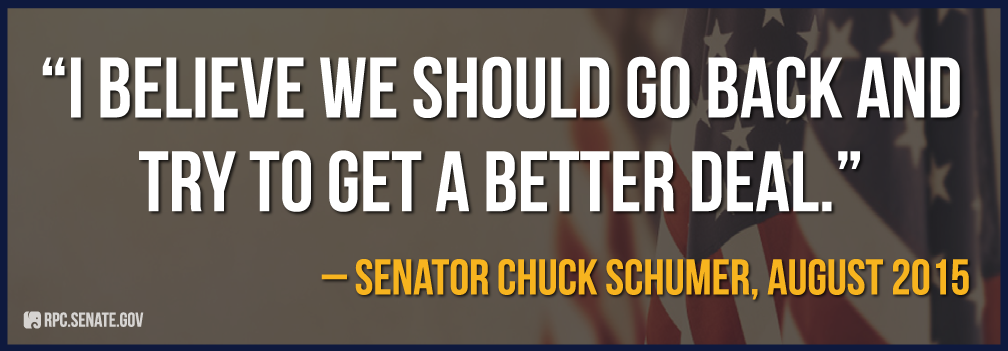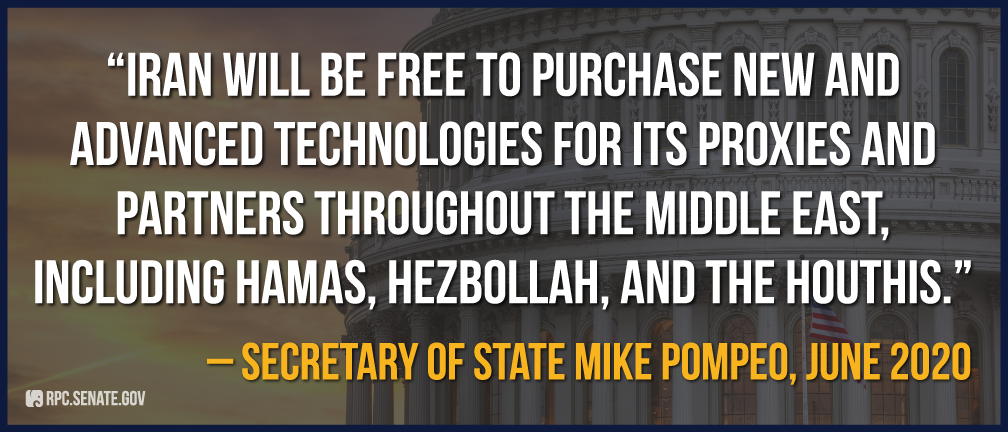Applying Pressure on Iran
KEY TAKEAWAYS
- Under the 2015 Iran nuclear deal, an arms embargo on Iran is due to be lifted this month, potentially allowing advanced weapons to flow into the hands of terrorists in the region.
- The Trump administration is pursuing a “maximum pressure” campaign against Iran to force an end to the country’s illicit nuclear program and other malign activities.
- Part of this pressure campaign is attempting to snap back sanctions that had been lifted under the 2015 deal.
Over the summer, the United States moved to invoke the “snapback” provision of the 2015 Iran nuclear deal. This was designed to reinstate U.N. sanctions, including arms embargoes that had been lifted by the deal, if Iran fails to comply with the terms of the agreement. This action is one of a series by the U.S. in a campaign of “maximum pressure” to force the Iranians back to the negotiating table.
Iran Nuclear Deal
The United Nations Security Council adopted Resolution 2231 on July 20, 2015. The resolution endorsed the Joint Comprehensive Plan of Action between Iran and the “P5+1,” which consisted of China, France, Germany, Russia, the United Kingdom, and the United States. The P5+1 agreed to lift certain sanctions in return for Iran scaling back its nuclear program.

President Obama entered into the JCPOA even though a majority of the Senate disagreed with the pact’s intent and expressed a variety of concerns. The current Democratic minority leader, Senator Chuck Schumer, opposed the deal at the time, saying, “I believe we should go back and try to get a better deal.” He said the lack of restrictions on Iran’s non-nuclear programs makes a “strong case that we are better off without an agreement than with one.” Bipartisan observers have worried that the deal’s structure will embolden Iran while providing an eventual path to nuclear weapons, because the core limitations on Iran’s nuclear enrichment capabilities and production capacity expired in 10 to 15 years. In addition to these problematic “sunset provisions,” the JCPOA failed to address Iran’s destabilizing regional behavior and support for terrorism, and it provided substantial sanctions relief.
Maximum Pressure Campaign
With President Trump’s announcement in 2018 that the U.S. would no longer abide by the JCPOA and would reimpose U.S. sanctions against Iran, the administration began a policy of what it called “maximum pressure.” The United States has added a series of economic sanctions to cut off funding and support for the Iranian regime. The goal of this pressure was to force the Iranians back to the negotiating table to craft a deal that addresses all of Iran’s destabilizing behavior.

Most recently, the U.S. sanctioned 18 Iranian banks and invoked the snapback mechanism in the Iran nuclear deal to increase pressure. The other parties to the Iran deal view the U.S. snapback action as invalid due to U.S. non-participation in the deal since 2018, and they will not enforce or recognize the move. The Trump administration argues that since the resolution governing the deal does not have a withdrawal clause, the U.S. can still invoke the snapback even after its 2018 announcement. Prior to announcing the intended snapback, the U.S. also introduced a resolution at the Security Council to extend an embargo on conventional arms that is set to expire on October 18 under the JCPOA. The measure failed, with Russia and China voting against the extension and 11 countries abstaining. Once the embargo ends next week, countries will be free to supply the Iranians with advanced conventional weaponry, and Russia is already signaling it will. The EU maintains its own embargo, and President Trump issued an executive order to take action against anyone who supplies Iran with arms.
Instead of negotiating, the Iranian regime continues to take destabilizing military action in the region in response to increasing U.S. pressure, highlighting the continuing danger Iran poses. These activities include the downing of a U.S. drone, attacks on Saudi oil fields, the seizing of oil tankers, and attacks in Iraq targeting U.S. interests. The Trump administration responded in January 2020 by killing Qasem Soleimani, the leader of Iran’s Islamic Revolutionary Guard Corps’ Quds force and architect of many attacks against Americans. The U.S. maintains a significant troop presence in the region to counter Iranian hostilities.
Next Article Previous Article
